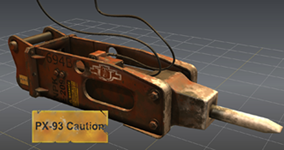When you paint on a model in Mudbox, the paint is applied to a paint layer. A layer relates to the actual 2D bitmap image you are painting behind the scenes.
A paint layer is fully transparent until you paint on it, so areas of the layer with no paint allow the underlying material or underlying paint layers to show through. As you create more layers, they are stacked on top of each other to produce the final result.
You must have at least one paint layer created and selected to paint on a model. The first time you paint without any paint layers, the Create New Paint Layer window automatically appears to let you create one. Any paint layers you create are automatically saved with your .mud file.
You manage paint layers using the Layers window by selecting the Paint display button. See also Paint Layers window.
You can paint different types of information on paint layers. For example, the default paint layer is diffuse color. This paints the color you specify into a diffuse channel that appears as a component of the object’s material. You can also paint gloss, specular, reflection, and bump values directly onto models using the 3D paint tools with layers. For more information on the material properties you can paint, see Channel (in the Create New Paint Layer window).
You can create paint layers with different resolutions and bit depths on the same model (unlike many other paint applications that require one consistent canvas size). This is extremely useful if you need to conserve the amount of texture memory a material uses.
If your model has UVs, you can paint across multiple UV tiles (provided the UVs for your model are laid out in this way) and take advantage of the increased texture resolution this technique can provide. Mudbox automatically manages the layers and associated images for each UV tile. For more information, see Paint across multiple UV tiles.

Paint information is saved as discrete channels. You can modify the properties on a particular paint layer (for example, opacity) or delete it without affecting the texture properties on other layers.
You can view how your texture painting appears in the 2D texture space of your model using the UV View. The UV texture coordinates for the model are also displayed which can be a useful visual reference. Sculpt and paint layers can be used in combination to let you split surface detail for a material - for example, you can create texture map sets for a shading material with separate channels for skin, mud, warts, and scars, and then store each channel's detail on a separate layer. You can also view the images you paint using the Image Browser.
Paint layer task overview
| Task | General description |
|---|---|
| Create a new paint layer |
Use paint layers to organize your work into logical segments, keeping various details separate from one another. For example, paint wrinkles, pores, scars, and acne on a character’s face on separate layers. Paint the skin of a character separately from its clothing or accessories, or paint the model’s base color separate from other details such as stripes, logos, dirt, or decals. |
| Blend paint layers |
Set different layer blend modes to modify the resulting texture. |
| Import an image as a texture map |
You can import images to paint layers, for example if you have created the texture in another application and want to apply it in Mudbox. |
| Merge paint layers |
Build up new paint on your model safely without affecting previous paint work. For example, you might get to a stage of painting and decide to continue painting on another layer, then merge the two layers together when you are finished. Merging layers reduces the amount of texture memory used by the file. |
| Duplicate a paint layer |
Copy an image and add paint without affecting the original. Since a new layer is transparent, you can view the other layers below it for reference as you paint. |
| Hide or show a paint layer |
Create and compare different versions of the same image. You can adjust the opacity of a layer, or hide it. |
| Move paint layers |
The order of layers and their opacity/transparency values produce the model’s net coloring. Drag and drop to rearrange them. You can also drag a layer to a different paint layer channel type to change how it is rendered on the model. |
| Use Mudbox and Photoshop together |
Export paint layers to other image editing applications such as Adobe Photoshop and transfer your paint work back and forth between the two applications. |
| Import a paint layer |
You can import images into a layer and edit the images using the Paint Tools. |
| Export paint layers |
Export paint layers as maps in a variety of file formats. |